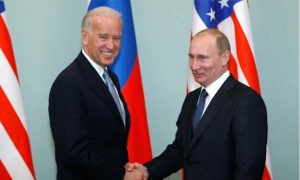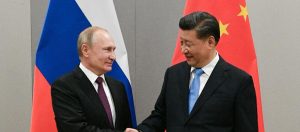THE NEW COLD WAR: A TRIPARTITE COMPETITION FOR WORLD HEGEMONY

*By Pierre A. Sarkis
From very early on, the world has been subject to conflicts and wars between Cavemen, Tribesmen, Bedouins, Nomads, Ethnic Groups, Dynasties, Empires, Powers and Superpowers, all vying for power and influence. At times, great powers and empires competed for world control, such as, Russia and Britain in the 18th and 19th Centuries, in what became known as the Great Game. By the 20th Century, most of those entities mentioned above, gave way to first class powers, or superpowers, like the United States of America and the Soviet Union, and second-class powers, such as, Britain, France, China, Germany, India, Brazil, and Japan, among others. The remaining countries were classified as Third World Nations, or underdeveloped countries, which were subjected to colonialism in past centuries, with many of them still nowadays at the mercy of these first and second-class powers, in what became known as the countries of the rich and wealthy Industrial North, and countries of the poor, destitute, and impoverished Agricultural South.
Following World War II, the world was immersed in Cold War politics dividing it into a Capitalist and a Communist Camp vying for world hegemony. While the US and the Soviet Union totally dominated world affairs in the 20th Century, and still do, the dawning of the 21st Century introduced a third, fast-emerging economic and military power, China, whose ambitious economic program and military expansion announced its presence on the world stage, a powerful presence that cannot be ignored. The competition between the three powers is becoming fierce, and stretching around the globe in what might become a new tripartite Cold War.
Fueling this competition are the constant attempts by the US to encircle both countries in their backyards, causing tensions in their relations and endangering world peace. US policy following the Second World War focused on a policy of containment of Communism, per US President Harry Truman’s Doctrine, to prevent the spread of communism to Europe, the Middle-East, Africa, Asia, South-East Asia, and the Far-East. The US created alliances and pacts for this purpose, NATO (North Atlantic Treaty Organization) in Europe, The Baghdad Pact or CENTO (Central Treaty Organization) in the Middle-East, and ANZUS (Australia, New Zealand, The US) in the Pacific Ocean Basin. These alliances and pacts were aimed specifically at the Soviet Union and China, with the US stationing troops in some of the countries on the peripheries of both powers, as in Europe and Turkey, where nuclear missiles were directed at Soviet territories and WARSAW Pact countries under Soviet rule. In the CENTO region, Britain had troops stationed in some of the member countries, and was mostly responsible for their protection. In the Pacific region, the US stationed troops in Vietnam, South Korea, facing the pro-China communist regime of North Korea, as well as, in the Philippines, at Clark Air Base and Subic Bay Naval base, while US troops were already stationed in Japan after the latter’s defeat in World War II. In addition, the US was patrolling oceans around the world through its several nuclear aircraft carrier groups and nuclear submarines.
Tensions arose in 1962, after the Soviet Union placed nuclear missiles in Cuba, just 103 miles from the shores of the state of Florida in the US. Then US President John F. Kennedy, considered the Soviet move a direct threat to the US mainland, although US missiles stationed in Turkey threatened Soviet territories directly across the Black Sea and the Caucuses. Since Soviet power was no match for US power at that time, Soviet Leader Nikita Khrushchev backed down, and the world was spared a nuclear encounter between the two superpowers, the closest the world has ever come to a nuclear war. Tensions increased following the Cuban Missile Crisis, and confrontations by proxy took place between the US and the Soviet Union in some areas of the world. It was obvious that the Cold War reaffirmed the Halford Mackinder theory of the Eurasian Heartland, and Alfred Mahan’s theory of Naval Power. Mackinder believed that whoever controls Eurasia, or the heartland, which is today the mass of land covering Russia and Eastern Europe, controlled the world. Mahan believed that whoever controls the Seas, Oceans and the straits and waterways on their edges, controlled the world. Their theories were deduced from the Great Game between Russia and Britain. The Russian Empire controlled all land masses in Eurasia, from the Pacific Ocean in the East, to the Atlantic Ocean and Baltic Sea in the West. The British Empire’s naval power stretched all over the maritime countries, along the oceans and seas with their straits and waterways, thus preventing Russia from fulfilling ancient Tzarist dreams of establishing warm water ports to the South of Eurasia, that could have strengthened and solidified its campaign for world hegemony. The constant most intense indirect confrontation between the two empires during the Great Game happened in Central Asia, in areas on the periphery of the Silk Road, the strategic trade route linking China and South East Asia to Europe. Eventually, Russia annexed all this area under the Soviet Union, in what became known as the Soviet Asian Republics (SSR), such as Kazakhstan, Uzbekistan, Turkmenistan, Tajikistan and Kyrgyzstan, and thus, and with its control over Central and Eastern Europe (WARSAW Pact), completed its total domination of Eurasia, the heartland.

Which brings us to a new Cold War involving this time around, along with Russia and the US, a fast-emerging additional world power, China, which is directly ascending the echelons of world hegemony, mostly through that same road, which Britain and Russia fought over during the Great Game, the Silk Road, the core of China’s ambitious drive towards superpower status. In this new Cold War, the US is fighting along two fronts against formidable opponents: China in the Far East, and its presence in Africa, the Pacific and Indian oceans; and Russia in Europe, and especially in the Ukraine, and its presence in the Mediterranean Basin and the Black Sea.
Recently, Russia finally succeeded in securing a warm water port and an air base in Syria, following its support of the Regime of Syrian President, Bashar Al Assad, and thus, established a strong presence in the Mediterranean Sea, with a close watchful eye on the Dardanelles and the Bosphorus, the two strategic straits linking the Mediterranean Sea to the Black Sea. It is estimated that the straits make way for around 48000 ships annually, three times denser than the traffic of the Canal Suez, and four times more than the Panama Canal, and is vital for Russia’s trade and military presence, since the Russian Black Sea Fleet’s headquarters is at Sevastopol, inside the Black Sea. With Russian troops buildup on the Ukrainian borders, the Ukraine being a NATO member, Russia is continuing to build up its naval presence, while Britain deployed two warships to beef up NATO’s presence in the Black Sea, with more US warships heading in that direction. This also raised tensions between Russia and Turkey, another NATO member, which controls the two strategic straits. As if history always repeats itself, it seems that the world is poised to experience another Cold War, very similar in players and proxies to the Great Game between Russia and Britain, and the Cold War between the US and the Soviet Union. The fact that Russia always experienced encirclement by the West, pushed Russian President Vladimir Putin to warn the US and NATO, that any encroachment on red lines will be met very forcefully and swiftly. Earlier, US President Joe Biden had called Russian President Vladimir Putin a murderer, and sanctions were imposed on Russia, followed by the expulsion of ten Russian diplomats, which forced Russia to retaliate by expelling ten US diplomats. All indications point to a new Cold War between the two world powers.

But both powers would not be alone in this new Cold War. On the other side of the globe, a similar scenario is in the making between the US and China. First, and foremost, in the confrontation between the two lies the economic factor, and specifically, the New Silk Road, or “the Belt and Road Initiative”, that China is launching. It was in the last years, that tensions between the two great powers escalated on the account of US charges against Chinese piracy of US intellectual-property, as well as, China’s dismal human rights record, including the suppression in Hong Kong, and the mass arrests of Moslem Chinese Uighurs. Added to all that is the increased Chinese military expansion in Asia.
The issue of Taiwan, which is considered by China as Chinese land, is a matter of historic conflict between the US and China, as the Chinese consistently reiterate that the Taiwan issue is an “internal Chinese matter.” China’s military presence in the Taiwan Strait and its military buildup in the South China Sea is of tremendous concern to the US, especially in the Paracel and Spratly islands, claimed by several countries in the Pacific Rim Area. Both islands are important for economic and strategic reasons. The Spratly area holds potentially significant, still unexplored reserves of oil and natural gas, and is a productive area for world fishing, and one of the busiest areas of commercial shipping traffic. They sit astride major maritime trade routes to Northeast Asia, giving them added significance as positions to monitor maritime activity in the South China Sea, and to potentially base and project military force from. The area of the Paracel Islands is also strategically located and is believed to hold substantial gas and oil deposits. China claims sovereignty over both island groups and several Atolls located nearby. The US denies China’s claims to sovereignty over the islands, since ownership of the islands has been a matter of dispute between different countries.
US strategy today is centered around the priority of facing China in two strategic theaters, the Pacific and Indian Oceans through establishing an active four-nation alliance including along the US, Japan, India and Australia. In response to US military presence in the Pacific, close to Chinese borders, the Chinese leadership sternly reiterated the fact that no Chinese warships were roaming the shores of the US Mainland in the Pacific and Atlantic Oceans, neither in the Caribbean, nor in the Gulf of Mexico. In this respect, the goal of China’s “Belt and Road Initiative”, is not only to build a strong and wide economic influence on the geographic-economic level, but to build and solidify strategic political influence for China on a global level. In the Middle East, Africa, and South America, the Chinese upsurge is elaborated through the economic gate, working on creating cooperation and partnerships with competing or hostile regional powers, showing its authority inside the world order, especially after joining emerging economic powers, namely the BRICS Group, with India, Russia, Brazil and South Africa, comprising nearly a third of the world’s population. This reflects the new Chinese political strategy, a pragmatic one far from any ideological attributes.
In concluding, it seems obvious that the world has entered a new phase of fierce competition between the US, Russia and China. Unlike the first cold war between the US and the Soviet Union, this new cold war seems to take an economic character which overshadows the military one. However, in today’s global relations, economic success is very much dependent on the geographical aspects of the globe, its masses of land, oceans, seas, islands, archipelagos, atolls, and straits. In today’s race for global hegemony, it seems that Mackinder and Mahan’s theories of the Heartland vs naval power is still alive and well, with some intertwining between them, as the three powers calculate which parts of both theories fit their aspirations for world domination.
Bishmizzine, 06/05/2021
*Expert in Russian Area Studies/The Soviet Union
Retired Instructor of International Relations, Political Science, History and Cultural Studies at the Lebanese American University, Byblos and Beirut.
References:
Salim Nassar, Al Nahar Newspaper, 10 April 2021
Nassif Hitti, Al Nahar Newspaper, 20 April 2021

